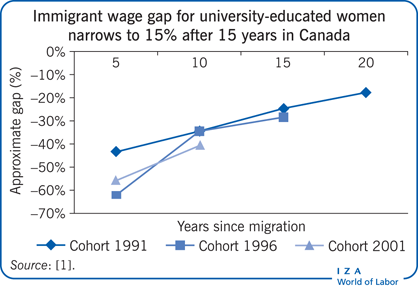Elevator pitch
What is the role of married women in immigrant households? Their contribution to the labor market has traditionally been considered of secondary importance and studied in the framework of temporary attachment to the labor force to support the household around the time of arrival. But this role has changed. Evidence from major immigrant-receiving countries suggests that married immigrant women make labor supply decisions similar to those recently observed for native-born married women, who are guided by their own opportunities in the labor market rather than by their spouses’ employment trajectories.
Key findings
Pros
Immigrant women are increasingly participating in the labor market and are experiencing rapid earnings growth.
Low-educated immigrant women reach wage parity with comparable native-born women.
Highly educated immigrant women are shifting from physical strength-intensive jobs to jobs requiring more analytical skills.
Cons
The large presence of educated immigrant women in low-skill occupations suggests significant obstacles at entry.
Highly educated immigrant women do not experience wage or analytical skill parity with comparable native-born women.
Erroneous perceptions of immigrant women as secondary workers slows their integration into the labor market.
A comprehensive study of labor market outcomes of immigrant women is impeded by data limitations on household composition and lack of data on the same women over time (panel data).
